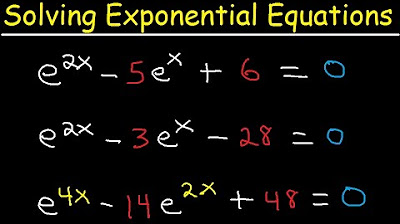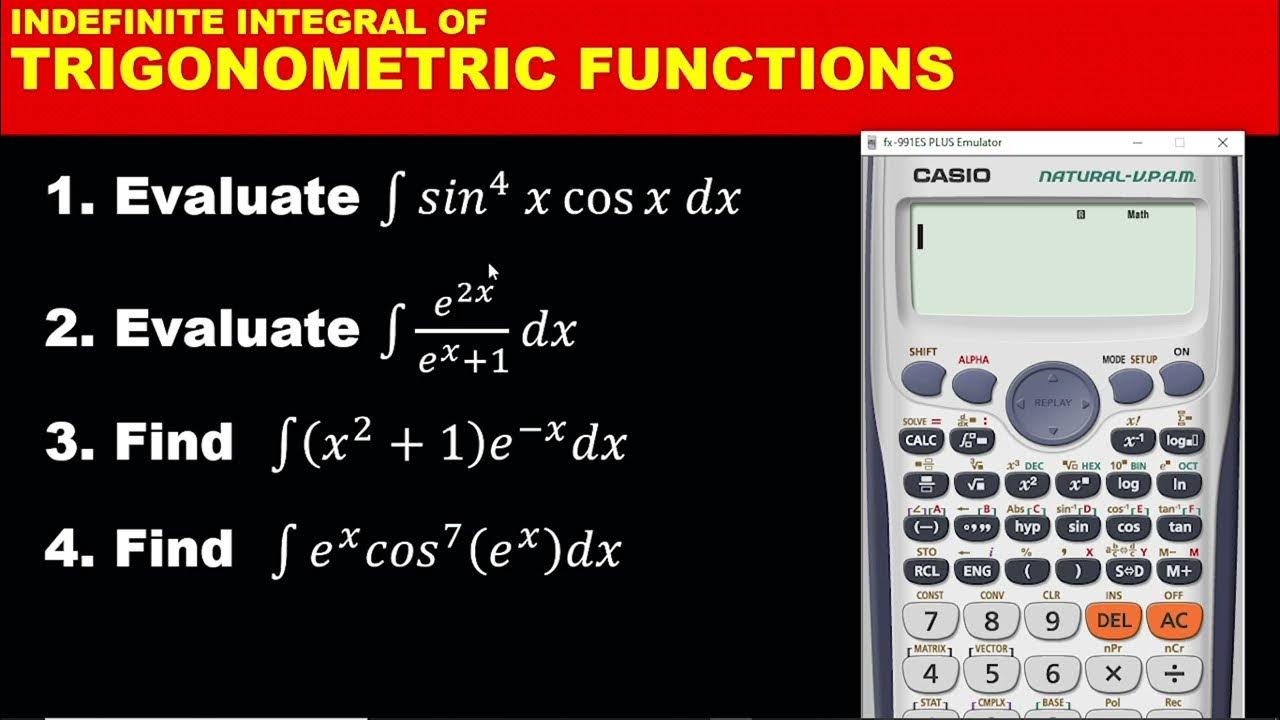Multiplying Power Series
TLDRThis video tutorial offers a practical approach to multiplying power series, focusing on simplifying the process with examples. It covers finding the fifth-degree Maclaurin polynomial for e^(2x) and sine(2x) in parts A and B, respectively. The video cleverly leads to part C, where the product of e^(2x) and sine(2x) is derived without extensive derivatives, by multiplying the previously obtained polynomials. The method emphasizes using memorized series and compositions to efficiently solve these problems, providing a clear and concise strategy for students to master.
Takeaways
- 🔢 The video discusses multiplying power series, a fundamental concept in calculus.
- ✏️ Part A involves finding the fifth-degree Maclaurin polynomial for e^{2x}.
- 📐 Part B requires finding the fifth-degree Maclaurin polynomial for sin(2x).
- ➗ Part C focuses on finding the polynomial for e^{2x} imes sin(2x) using results from Parts A and B.
- 📝 The instructor emphasizes memorizing common series expansions like those for e^x, sin(x), and rac{1}{1 - x}.
- 🔄 The method involves substituting 2x for x in the series expansions.
- 📊 For e^{2x}, terms are derived by replacing u with 2x in the series expansion.
- 🧮 For sin(2x), only odd powers are considered due to the properties of sine functions.
- ✂️ The instructor simplifies the process by dropping higher power terms that exceed the desired degree.
- 🔀 Combining the results from e^{2x} and sin(2x), terms are multiplied and simplified to form the final series.
Q & A
What is the main topic discussed in the video?
-The main topic discussed in the video is multiplying power series, specifically finding the Maclaurin polynomials for e^(2x), sin(2x), and e^(2x) * sin(2x).
What is a Maclaurin polynomial?
-A Maclaurin polynomial is a type of power series expansion of a function centered at zero. It is used to approximate functions and is named after the Scottish mathematician Colin Maclaurin.
What are the steps involved in finding the Maclaurin polynomial for e^(2x) in the video?
-The steps involve writing down the general form of the power series for e^u, replacing every 'u' with '2x', and simplifying the expression to obtain the polynomial up to the desired degree.
How is the Maclaurin polynomial for sin(2x) derived in the video?
-The Maclaurin polynomial for sin(2x) is derived by using the known series for sin(u), replacing 'u' with '2x', and considering only the odd powers of 'x' with their respective factorials, alternating signs.
Why is it easier to find the Maclaurin polynomial for sin(2x) compared to e^(2x)?
-It is easier because sine is an odd function, which means only odd powers of 'x' are involved, and fewer terms are needed to reach the desired degree compared to the exponential function.
What is the strategy used in the video to find the polynomial for e^(2x) * sin(2x)?
-The strategy involves multiplying the polynomials obtained for e^(2x) and sin(2x) term by term, simplifying the coefficients as you go, and ensuring the resulting polynomial is of the desired degree.
Why is it beneficial to multiply the polynomials for e^(2x) and sin(2x) instead of finding the product series directly?
-Multiplying the polynomials is more efficient because it avoids the need to find and multiply the derivatives of the product series, which would be a more complex and time-consuming process.
What is the significance of the factorial terms in the power series?
-The factorial terms in the power series are crucial as they determine the coefficients of the terms in the series. They are used to ensure the series converges to the function it represents.
How does the video simplify the coefficients during the multiplication of the polynomials?
-The video simplifies the coefficients by multiplying the terms and reducing the resulting expressions, ensuring that the final polynomial is as simple and accurate as possible.
What is the final result of the polynomial for e^(2x) * sin(2x) obtained in the video?
-The final result of the polynomial for e^(2x) * sin(2x) is approximately 2x + 4x^2 - (16/15)x^5, with no x^4 term in the final expression.
Outlines
📚 Introduction to Multiplying Power Series
This paragraph introduces the topic of multiplying power series, emphasizing it as a 'just do it' type of topic. The speaker outlines the structure of the video, which includes finding the fifth-degree Maclaurin polynomial for e^(2x) in Part A, sine(2x) in Part B, and the product of e^(2x) and sine(2x) in Part C. The approach involves using memorized series for e^x and sine/cosine, and applying compositions with 2x. The speaker also hints at a method to simplify the multiplication of these series without extensive derivation.
🔍 Detailed Process of Multiplying Power Series
The second paragraph delves into the detailed process of multiplying the power series for e^(2x) and sine(2x). The speaker explains how to use the memorized series for e^x and sine, and how to apply the composition with 2x to find the respective polynomials. The method involves multiplying terms from the two series, simplifying coefficients, and ensuring the resulting polynomial is of the fifth degree. The speaker also discusses the simplification of terms and the elimination of unnecessary terms to keep the polynomial within the desired degree. The final result is a polynomial that combines the series of e^(2x) and sine(2x), demonstrating a practical approach to solving such problems without extensive calculations.
Mindmap
Keywords
💡Power Series
💡Maclaurin Polynomial
💡Composition
💡Factorial
💡Exponential Function
💡Sine Function
💡Odd Function
💡Taylor Series
💡Derivative
💡Multiplication of Series
💡Term-by-Term Multiplication
Highlights
The video discusses multiplying power series, a topic that requires practical application.
Part A involves finding the fifth-degree Maclaurin polynomial for e^(2x).
Part B focuses on the same task for the sine of 2x.
Part C combines the results of A and B to find the product of e^(2x) and sine of 2x.
The process is simplified by using memorized series for e^x and sine x.
The general form of a power series is presented as 1 + u + u^2/2! + u^3/3! + ...
For e^(2x), the series is approximated by substituting u with 2x.
Sine's series involves odd powers and alternating signs, requiring fewer terms for the fifth degree.
The composition with 2x for sine of 2x is demonstrated.
Memorization of sine and cosine series is emphasized for efficiency.
Part C is approached by multiplying the polynomials obtained from Parts A and B.
The multiplication process is simplified by dropping terms that exceed the fifth degree.
The term-by-term multiplication method is used to find the final polynomial.
Coefficients are simplified during the multiplication to avoid complex expressions.
The final polynomial for e^(2x) times sine of 2x is presented.
The method avoids extensive derivative calculations by using known series.
The video concludes with a summary of the process and its practical applications.
Transcripts
Browse More Related Video

Power series of arctan(2x) | Series | AP Calculus BC | Khan Academy

Product To Sum Identities and Sum To Product Formulas - Trigonometry

Solving Exponential Equations In Quadratic Form - Using Logarithms, With e

INTEGRATION PART 2: CALCULATOR TECHNIQUES ON INDEFINITE INTEGRATION OF TRIGONOMETRIC FUNCTIONS

Worked example: Maclaurin polynomial | Series | AP Calculus BC | Khan Academy

Definition of the Derivative Quickies
5.0 / 5 (0 votes)
Thanks for rating: